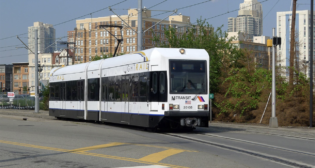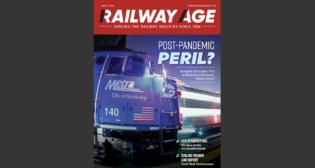
Digital Transformation and Rail
Written by Don Bridges
Shutterstock
The railroad industry is embracing its own digital transformation. In his address to shareholders at the May 13, 2021 annual meeting, Norfolk Southern chief executive Jim Squires made a statement in-line with a vision that is becoming more common across the rail industry: “We are moving quickly to lead the industry in innovation, launching our Digital | NS initiative, and building the digital railroad of the future.”
Digital Transformation is a 25-year-old concept with many definitions and applications. At its core, digital transformation focuses on using data to improve safety, system utilization, operation, and/or maintenance:
- Passengers need to understand how best to get from point A to point B at a given time based on a multitude of factors that could affect the journey. Riders don’t want a system timetable; they want information specific to their real-time needs.
- Train crews need to quickly and efficiently understand the operational and safety aspects of the specific equipment they are operating.
- Maintenance personnel need to be able to refer to documented processes to safely and economically return an asset to service.
In a world where information, conditions and regulations are constantly changing, manufacturers and operators are challenged to provide always-correct information. As railroads may be owned by multiple entities, it’s not unusual for a route to involve utilization of tracks owned by multiple entities. Each railroad will likely have its own rulebook, requiring the operator to have ready access to multiple rulebooks depending on their physical location.
Key Challenges of a Paper-Based Approach
Traditional printed or faxed hardcopy pages are the defacto standard, but there are business challenges associated with paper:
- Delivery of manuals is an expensive and inefficient process. Print and delivery costs of paper manuals can be tens or hundreds of thousands of dollars annually.
- Verification of Receipt is a compliance risk. It is difficult and expensive to verify that an updated manual was received and reviewed, creating compliance and safety risks.
- Paper manuals are heavy. Front line railroad operations employees may carry around upwards of 40 pounds of paper for bulletins, rulebooks and other safety-required information.
- Updates must be manually inserted. Employees have to remove outdated pages and replace them with updated pages. This is a monotonous and time consuming process prone to errors.
- Paper is easily damaged. Frequently accessed pages are the most likely to be damaged with a smudge or lost in the normal course of use.
To address these issues, paper is being replaced by PDF files that act as “electronic paper” on a monitor or tablet screen. PDF delivery addresses paper distribution issues such as the inability to provide timely, updated content. However, content delivered by PDF still falls short of what the modern end-user needs: focused, up-to-date and always-correct information and answers, regardless of how the content is being accessed.

If paper and PDF content delivery are insufficient, what is a viable solution that economically meets the needs of Train and Engine (T&E) workers as content consumers?
As a regulated industry with similarities to rail, the air transportation market offers some insights. Airlines have historically used paper as a knowledge transfer mechanism. Twenty years ago, the adoption of PDF and electronic delivery was slowly replacing paper content delivery. In the past ten years, there has been a steady transition in the airlines to HTML and web browser content delivery to facilitate the use of tablets with their smaller screen size and capability for low-light viewing.
Amazon can be thanked (or blamed) for changes in content consumer activity. Search facets allow filtering of information based on pre-defined criteria so that users can quickly follow a breadcrumb trail of information to assist them in carrying out their objectives. Well beyond full-text search, facets allow information to be filtered to deliver the precise information needed.
Keolis Commuter Services
Keolis Commuter Services is the operating partner for the Massachusetts Bay Transportation Authority’s (MBTA) Commuter Rail network. As reported in Railway Age in May 2021, Keolis is implementing its own digital transformation—delivering electronic content using tablets. This transformation digitized rulebooks, bulletins, special instructions and other operational documents that more than 1,000 train conductors, locomotive engineers, track workers and other operational personnel would be required to carry when operating on the Commuter Rail network. With digital content delivery, Keolis and the MBTA are more easily able to verify that important updates to rules and operating procedures have been delivered to and read by relevant front line employees, further enhancing compliance and safety.
“This platform will make critical safety and compliance information even more accessible and easier to reference for our operational personnel. Further, updates to these materials will be much easier to administer,” said David Scorey, Keolis CEO and General Manager in January 2021.
Norfolk Southern
Norfolk Southern has started its own move from the paper world. In a January 2021 Railway Age article, Norfolk Southern Director Operating Rules Corey Veal said, “We look forward to providing our employees with an easy-to-use app that supports operational safety and compliance and creates a more efficient document management and delivery system.”
Amtrak

Amtrak announced in its Service Line Asset Line Plans for FY21-26 a Safety and Security solution called Mobile Document Compliance System (MDCS) that provides critical and federally required access to safety documentation by Amtrak Operations employees electronically through an application on a mobile device. Amtrak expects that the MDCS project will reduce printing costs, increase compliance and support Amtrak’s mobile workforce initiative. The solution replaces cumbersome paper processes with an application that delivers these required documents directly to the front line work force. The project was piloted with 65 individuals across the country to gain feedback and rectify issues prior to full scale rollout which involves 3,000-plus employees across the country from the company’s 2022 fiscal year. Emily Spang, Amtrak Director of Safety Technical Training, said, “This is going to ensure that the information that the Operating Practices team has and distributes to employees gets to the employees right at their fingertips with the iPad.”
Siemens Mobility
Equipment manufacturers have realized creating intelligent content is a win for the manufacturer and operators. In 2016, Siemens Mobility began operating state-of-the-art trains from a custom-built depot. To operate and maintain these trains requires an enormous amount of technical content, including maintenance and operating manuals. The information required to operate and maintain these trains needs to be accessible and technically accurate, so that drivers, maintenance technicians and engineers could keep trains available and running on a full-service contract. This content is needed to support a wide array of users, including drivers, maintenance technicians and engineers, who access it on a variety of devices.
Siemens identified waste in its existing processes and created an innovative system using the DITA XML data standard. “It has taken 50% less time to produce manuals, at significantly lower cost than previously, and we met our target to provide publications six months before the trains enter operation,” said John Straw, Publications Manager. Content delivery utilizes a web-based maintenance portal/knowledge base, iPad apps for drivers’ manuals and decision-tree-based reporting.
“If you speak to any technicians, they love the manuals. We estimate a 30% reduction in time spent on maintenance,” said Ben Wardle, Production Manager. “With this project we have resolved many initial queries before they become an issue. We are not leaving any ambiguity; there will be no confusion, which is what causes delays.”
Key Advantages of a Digital Approach
Intelligent delivery of company, operational and/or maintenance information offers key advantages over paper and fax and in some cases PDF:
- Provide Instantaneous and verifiable Delivery. Updated information is delivered any time a user’s device is on the network, and users can be required to acknowledge that content has been read and understood. No more faxing of time-sensitive or job-critical updates—and hoping that the information is received and reviewed.
- Provide Quick Access to Answers for Job-related Questions. Instead of a accessing an entire manual, users can quickly find the answers to their questions related to their specific issues. McKinsey reported that “employees spend 1.8 hours every day—9.3 hours per week, on average—searching and gathering information.” According to Interact Source, 19.8% of business time—the equivalent of one day per working week—is wasted by employees searching for information to do their jobs effectively. Quickly finding the answer minimizes non-productive time.
- Highlight “What’s New” Content. The pace of content changes can be overwhelming. By alerting staff to new information that might otherwise be buried within an update, safety and compliance are not compromised.
- Optimize Content for Tablets and/or Low-light Conditions. In a 2020 Government Fleet magazine article titled “Are Tablets the New Must-Have Technician Tool?”, cities like Madison, Wisc. and Vancouver, B.C., have already made the switch to tablets. Amy Sidwell, Manager of Street Operations for the City of Vancouver, said technicians are able to work more efficiently with tablets right in their bays.
- Deliver Personalized Content. Content can be filtered to specific equipment and/or specific roles in the organization. Users see only the information applicable to specific needs.
- Collect End User Knowledge. Users have the opportunity to provide feedback that is important to address potential improvements or errors, address training needs and/or improving the user experience and overall satisfaction levels. In one case, mechanics reported that they had a better way to perform a maintenance procedure and reported it as feedback. Unfortunately, their unapproved field procedure could cause damage to the equipment. This was used as an opportunity to explain how their new procedure could cause unintended damage and why mechanics should not use unapproved procedures. Feedback provides an organization with a better view of what it has to change and improve to reduce support cases.
Phased Solution Approach
Change management (sometimes abbreviated as CM) is a collective term for all approaches to prepare, support and help individuals, teams and organizations in making organizational change. Transitioning from paper to digital delivery is difficult for organizations, especially when they have always worked in a paper world.
To manage the transition, many organizations adopt a phased approach as illustrated in Figure 2:

If the typical paper and fax situation is called “Level 1,” transitioning to PDF delivery can be called “Level 2.” Compared to paper, PDF offers significant advantages such as providing instantaneous and verifiable delivery, collecting end user knowledge, greatly reducing the weight associated with paper-based content, and eliminating the need to manually insert revisions in a paper-based manual.
“Level 3” is called “intelligent delivery” and offers several advantages over PDF: Content is optimized for the browsing device and/or setting (beneficial for tablets and low-light conditions), quickly delivers answers instead of manuals, and allows for content to be tailored to the job description and location.
Level 3 treats operational content as data (in a non-PDF format) that supports intelligent delivery of content.
Summary
Electronic content delivery is proving to be a game changer for operations and maintenance functions in the rail industry. Operators can improve their efficiency, verification, compliance, and safety by changing the paradigm of how employees access needed information. In a world where information, conditions, and regulations are constantly changing, moving from paper and fax to intelligent content will not be only necessary, it will be required to increase operational performance.
Don Bridges manages Consulting operations at JANA. Based near San Antonio, Tex., JANA is a 48-year-old family-owned business focused on technical and policy documentation. JANA is technology agnostic, which allows its customers to have the best solution for their business needs. Don is a frequent conference speaker and has a B.S. degree in Mechanical Engineering from LSU.



